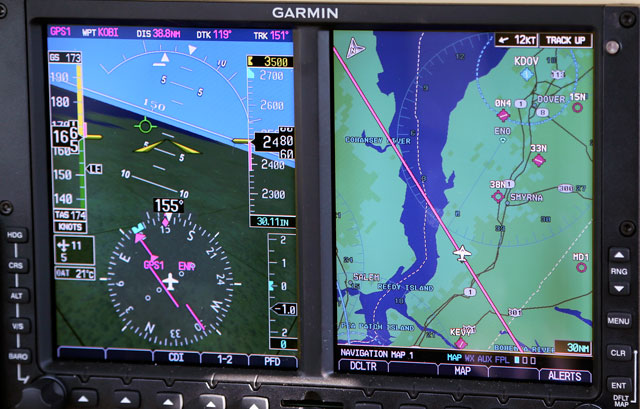Ownership: Salute to situational awareness
Garmin G500 delivers SA in spades

Inbound on an ILS to Runway 23 with a stiff breeze out of northwest, imagine my surprise when I glanced down at the horizontal situation indicator to find the localizer and glidepath indicators perfectly centered. “Whoa, this really works,” I said from underneath the hood to the safety pilot in the right seat. Despite the wind and a little turbulence, I was able to keep the green flight path marker on the new Garmin G500 primary flight display locked on the end of the synthetically depicted runway, even from several miles out. With that, the HSI needles stayed centered and locked. The flight, with Airbus pilot and Bonanza expert Adrian Eichhorn in the right seat, helped me peel back the many layers of situational awareness information available on the new display and focus on those that were most important in particular phases of flight.
With years of instructing in Bonanzas and flying glass cockpit airliners and business jets, Eichhorn expertly pointed out ways to leverage the enormous amounts of data available on aftermarket glass displays for GA. The recent panel upgrade to my Bonanza A36 must surely cause those who built the airplane in 1972 to scratch their heads. The upgrade to the G500 and installation of a touchscreen Garmin GTN 750 navigator and embedded new Mode S transponder and GDL 88 ADS-B transceiver has transformed the way I fly the airplane that I’ve owned for 14 years. The primary gear is supplemented by a new L-3 Avionics Systems Trilogy electronic standby indicator with its own battery backup and compass system. With the upgrade, the long-serving Garmin GNS 530W has been moved to the number two position. The multitude of screens gives me lots of places to display the Sirius XM datalink weather from the GDL 69 and the L-3 WX 500 Stormscope, both of which have been useful for years.
After battling with a finicky air-driven primary attitude indicator for a couple of years, I decided I needed to upgrade to something more reliable—solid-state had a nice ring to it. Todd Adams of Lancaster Avionics in Pennsylvania, who has managed all of my avionics projects for years, once again coached me through a panel upgrade that, as these things always do, expanded to other systems. Ultimately, my appetite for new technologies got pared back a bit as the reality of the budget hit. That upgrade to a new generation of engine monitoring and angle of attack indicator will make a nice phase two project when my savings account recovers.
With its solid-state attitude heading reference system, the G500 promises to be orders of magnitude more reliable than a spinning gyro powered by a vacuum pump that by design is wearing itself out with every turn. While it fits in the space of the original six-pack of mechanical flight instruments, the G500 packs far more situational awareness (SA) punch than those six. Especially with synthetic vision technology (SVT), which is optional on the G500 and standard on the more expensive G600, the system makes precise flying routine, but it does take training and practice to manage all of the information.
As can be seen in the photo on page 80, the G500 takes the basic information provided by each conventional instrument and appends much more to it in the form of trend lines, bugs, and digital readouts. In addition, the screen accommodates widgets of information simply not available in a conventional cockpit. For example, constantly calculated wind speed can be shown on both the PFD and multifunction side of the display in multiple formats. This is particularly helpful in choosing a cruise altitude; simply watch the wind speed and direction as you climb.
On an approach, the wind arrows and speed readout help establish correction angles. Most helpful, though is the flight path marker, the green barbed circle as part of SVT that shows where the airplane is headed, regardless of where the nose is pointed. As I quickly learned, anchoring that to the end of the synthetic runway assures you will get there every time. When flying an instrument approach, the runway numbers and stripes come into view, another SA tool to make sure you’re landing on the correct runway. Approaching the runway, the small window on the PFD containing the minimum descent altitude flashes and a voice annunciation reminds the pilot to prepare for landing or go around.
Get too low and expect SVT to change nearby terrain or obstacles to yellow and then red with additional “pull-up” guidance, both visual and aural. The G500 doesn’t yet display ADS-B-derived traffic information, but an upcoming software upgrade is expected to change that; the system already displays traffic from other sources.
Another useful tool that at first appears as only clutter is the zero-pitch line—a white horizontal line across the middle of the PFD. The line represents the aircraft attitude with respect to the horizon. Put the flight path marker on the zero-pitch line and the airplane is level—really helpful for leveling off from a climb or descent and also for steep turns. If the flight path marker stays on the white line, you will not climb or descend more than about 20 feet on even the steepest turns. The line also includes compass rose ticks, even more SA when making turns. Speaking of ticks, with SVT enabled, the pitch ladder changes in scale, making it easier to peg, say 7.5 degrees in the climb. Pitch too high or low and bright red chevrons appear on the PFD, providing guidance out of the unusual attitude.
With its ability to display terrain and obstacles, traffic, weather, approach plates, taxiway diagrams and more, the MFD side of the G500 warrants an article of its own. The GTN 750—a book of its own.
As with many pilots flying legacy airplanes with legacy panels, my goal in the upgrade was improved reliability over mechanical gyros. Like other electronic PFDs, the G500 delivers that. The real sleeper in the upgrade is the stunning amount of new information available to help make each flight more precise and safer.



